Why you can trust Tom's Hardware
Advanced Transient Response Tests
For details about our transient response testing, please click here.
In the real world, power supplies are always working with loads that change. It's of immense importance, then, for a PSU to keep its rails within the ATX specification's defined ranges. The smaller the deviations, the more stable your PC will be with less stress applied to its components.
We should note that the ATX spec requires capacitive loading during the transient rests, but in our methodology, we also choose to apply a worst case scenario with no additional capacitance on the rails.
Advanced Transient Response at 20% – 20ms
| Voltage | Before | After | Change | Pass/Fail |
| 12V | 12.137V | 11.953V | 1.51% | Pass |
| 5V | 5.040V | 4.949V | 1.81% | Pass |
| 3.3V | 3.327V | 3.182V | 4.36% | Pass |
| 5VSB | 5.075V | 5.029V | 0.90% | Pass |
Advanced Transient Response at 20% – 10ms
| Voltage | Before | After | Change | Pass/Fail |
| 12V | 12.139V | 11.968V | 1.40% | Pass |
| 5V | 5.040V | 4.938V | 2.02% | Pass |
| 3.3V | 3.327V | 3.185V | 4.26% | Pass |
| 5VSB | 5.075V | 5.015V | 1.18% | Pass |
Advanced Transient Response at 20% – 1ms
| Voltage | Before | After | Change | Pass/Fail |
| 12V | 12.140V | 11.957V | 1.51% | Pass |
| 5V | 5.041V | 4.938V | 2.04% | Pass |
| 3.3V | 3.328V | 3.196V | 3.96% | Pass |
| 5VSB | 5.075V | 5.026V | 0.97% | Pass |
Advanced Transient Response at 50% – 20ms
| Voltage | Before | After | Change | Pass/Fail |
| 12V | 12.107V | 11.991V | 0.96% | Pass |
| 5V | 5.027V | 4.933V | 1.86% | Pass |
| 3.3V | 3.316V | 3.165V | 4.54% | Pass |
| 5VSB | 5.034V | 4.989V | 0.89% | Pass |
Advanced Transient Response at 50% – 10ms
| Voltage | Before | After | Change | Pass/Fail |
| 12V | 12.108V | 12.007V | 0.83% | Pass |
| 5V | 5.028V | 4.924V | 2.06% | Pass |
| 3.3V | 3.316V | 3.168V | 4.46% | Pass |
| 5VSB | 5.034V | 4.972V | 1.23% | Pass |
Advanced Transient Response at 50% – 1ms
| Voltage | Before | After | Change | Pass/Fail |
| 12V | 12.109V | 11.999V | 0.90% | Pass |
| 5V | 5.028V | 4.926V | 2.03% | Pass |
| 3.3V | 3.316V | 3.178V | 4.15% | Pass |
| 5VSB | 5.034V | 4.983V | 1.02% | Pass |
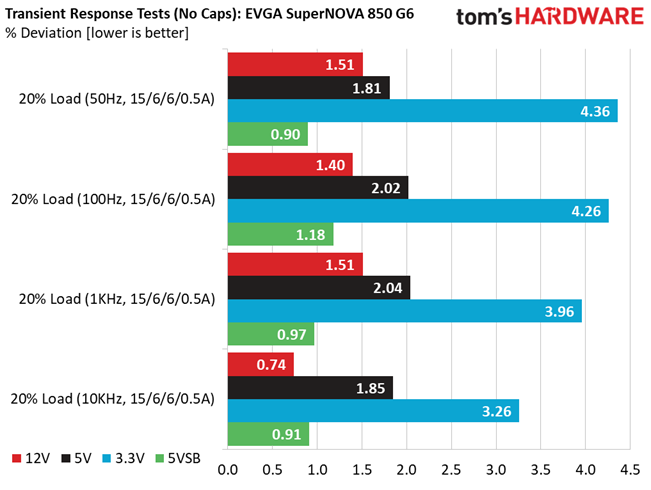
Results 25-29: Transient Response
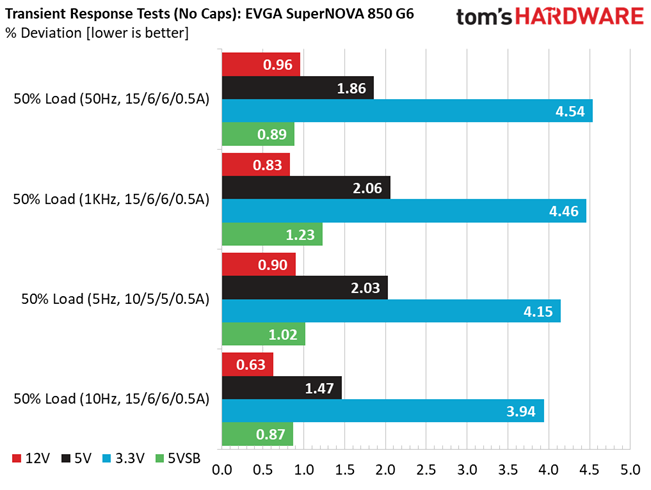

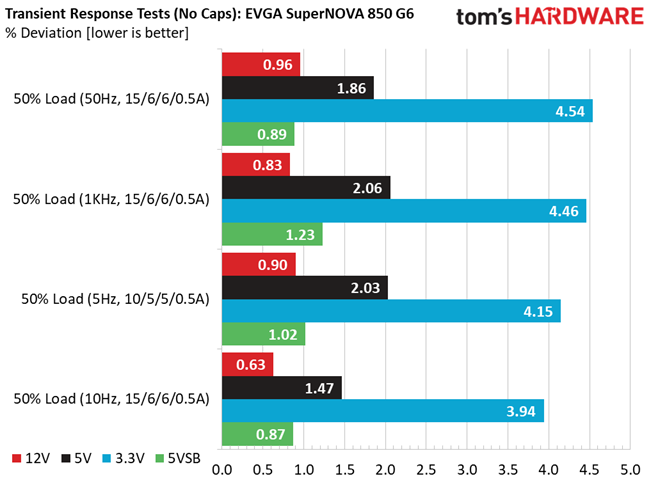

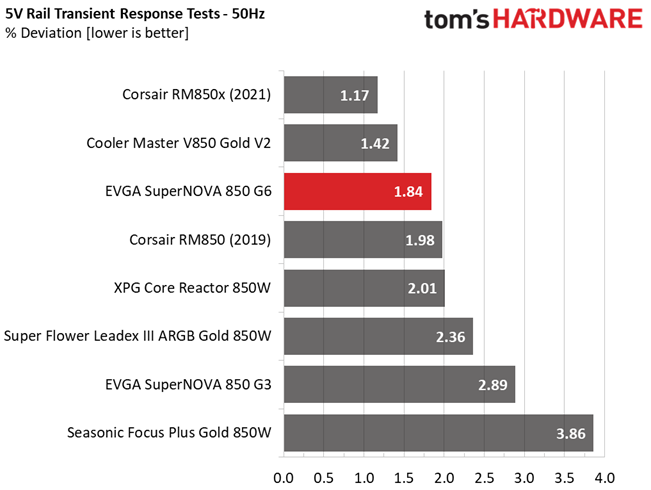


This unit's transient response is satisfactory at 12V, quite good at 5V and 5VSB and mediocre at 3.3V. Still, the PSU passes all 3.3V transient tests, but in all cases voltage drops below 3.2V once the transient load is applied.
Turn-On Transient Tests
In the next set of tests, we measure the PSU's response in simpler transient load scenarios—during its power-on phase. Ideally, we don't want to see any voltage overshoots or spikes since those put a lot of stress on the DC-DC converters of installed components.

Turn-On Transient Response Scope Shots


A small step and a tiny voltage overshoot at 5VSB are present here, but are nothing to worry about.
Power Supply Timing Tests
A power supply generates several signals, which need to be within certain ranges as specified by the ATX spec. If they are not, there can be compatibility issues with other system parts, especially mainboards. Since 2020, a PSU's Power-on time (T1) now has to be lower than 150ms and its PWR_OK delay (T3) has to be within 100 to 150ms to be compatible with the Alternative Sleep Mode.
Get Tom's Hardware's best news and in-depth reviews, straight to your inbox.
| T1 (Power-on time) & T3 (PWR_OK delay) | ||
|---|---|---|
| Load | T1 | T3 |
| 20% | 88ms | 134ms |
| 100% | 88ms | 134ms |
The PWR_OK delay is within the 100-150ms region here, so the PSU supports the alternative sleep mode recommended by the ATX spec.
Ripple Measurements
Ripple represents the AC fluctuations (periodic) and noise (random) found in a PSU's DC rails. This phenomenon significantly decreases a capacitors' lifespan because it causes it to run hotter. A 10-degree Celsius increase can cut into a cap's useful life by 50%. Ripple also plays an important role in overall system stability, especially when overclocking is involved.
The ripple limits, according to the ATX specification, are 120mV (+12V) and 50mV (5V, 3.3V, and 5VSB).
| Test | 12V | 5V | 3.3V | 5VSB | Pass/Fail |
| 10% Load | 8.0 mV | 10.3 mV | 11.5 mV | 4.9 mV | Pass |
| 20% Load | 18.2 mV | 10.4 mV | 10.8 mV | 5.5 mV | Pass |
| 30% Load | 10.8 mV | 10.2 mV | 11.2 mV | 6.1 mV | Pass |
| 40% Load | 10.2 mV | 11.3 mV | 11.9 mV | 7.1 mV | Pass |
| 50% Load | 10.4 mV | 12.0 mV | 16.0 mV | 11.3 mV | Pass |
| 60% Load | 10.7 mV | 12.8 mV | 12.5 mV | 8.8 mV | Pass |
| 70% Load | 10.5 mV | 13.5 mV | 12.6 mV | 14.5 mV | Pass |
| 80% Load | 11.0 mV | 13.6 mV | 14.1 mV | 12.5 mV | Pass |
| 90% Load | 11.3 mV | 13.2 mV | 13.8 mV | 11.8 mV | Pass |
| 100% Load | 15.2 mV | 14.7 mV | 15.9 mV | 15.3 mV | Pass |
| 110% Load | 15.5 mV | 17.2 mV | 18.1 mV | 15.3 mV | Pass |
| Crossload 1 | 9.4 mV | 12.1 mV | 12.6 mV | 6.2 mV | Pass |
| Crossload 2 | 8.0 mV | 11.0 mV | 11.3 mV | 5.6 mV | Pass |
| Crossload 3 | 9.0 mV | 10.0 mV | 13.3 mV | 5.4 mV | Pass |
| Crossload 4 | 15.2 mV | 13.8 mV | 14.3 mV | 13.8 mV | Pass |

Results 30-33: Ripple Suppression


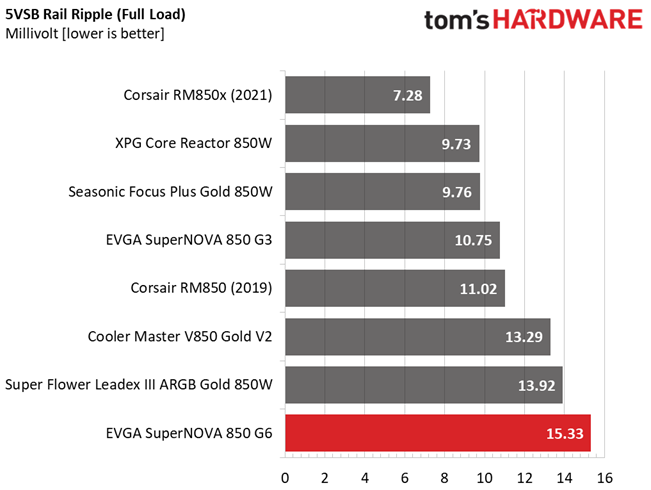
This PSU might not achieve the outstanding performance of the Corsair RM850x, but still, its ripple suppression is good on all rails.
Ripple At Full Load

Ripple Full Load Scope Shots



Ripple At 110% Load

Ripple 110% Load Scope Shots
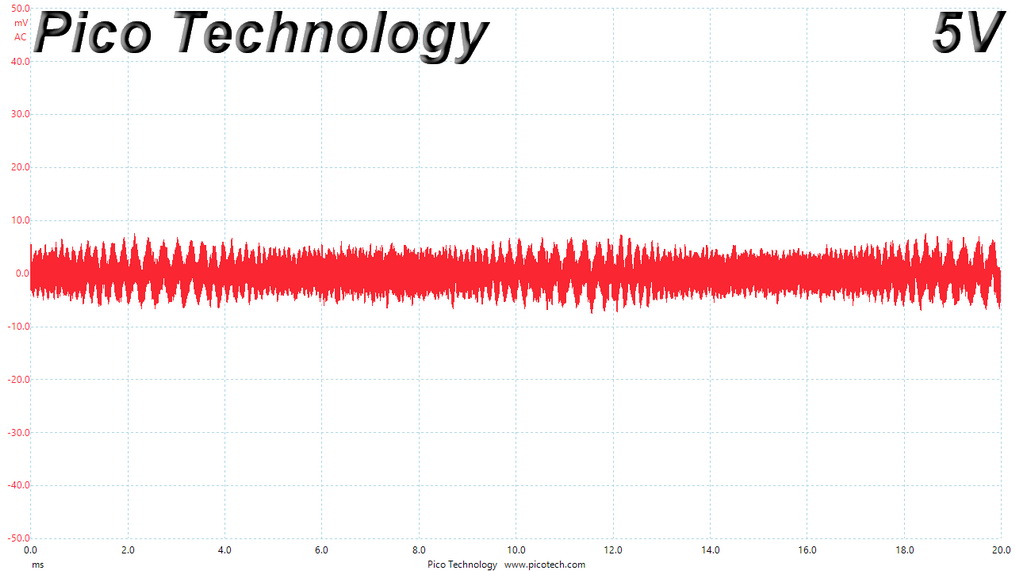


Ripple At Cross-Load 1
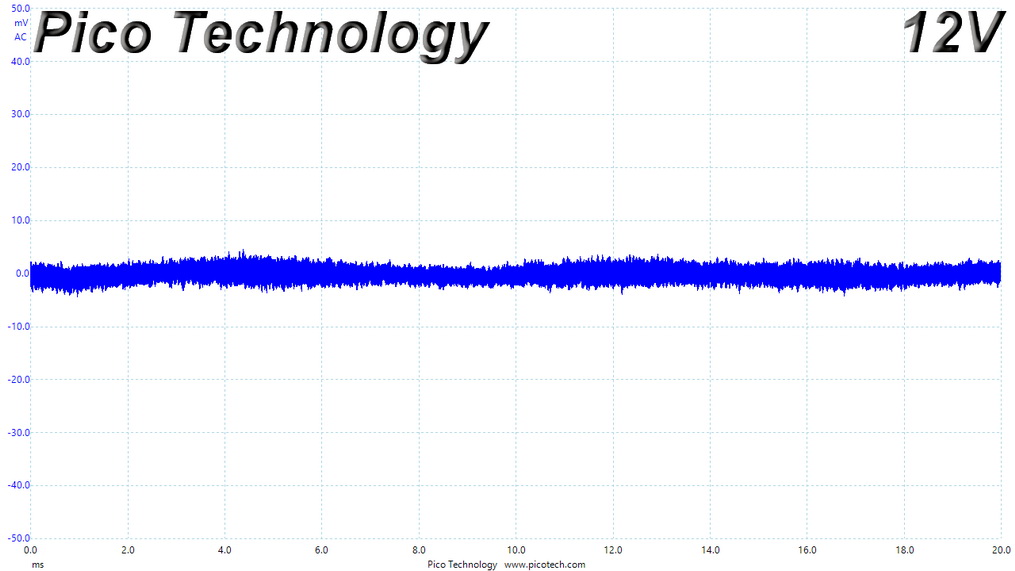
Ripple CL1 Load Scope Shots
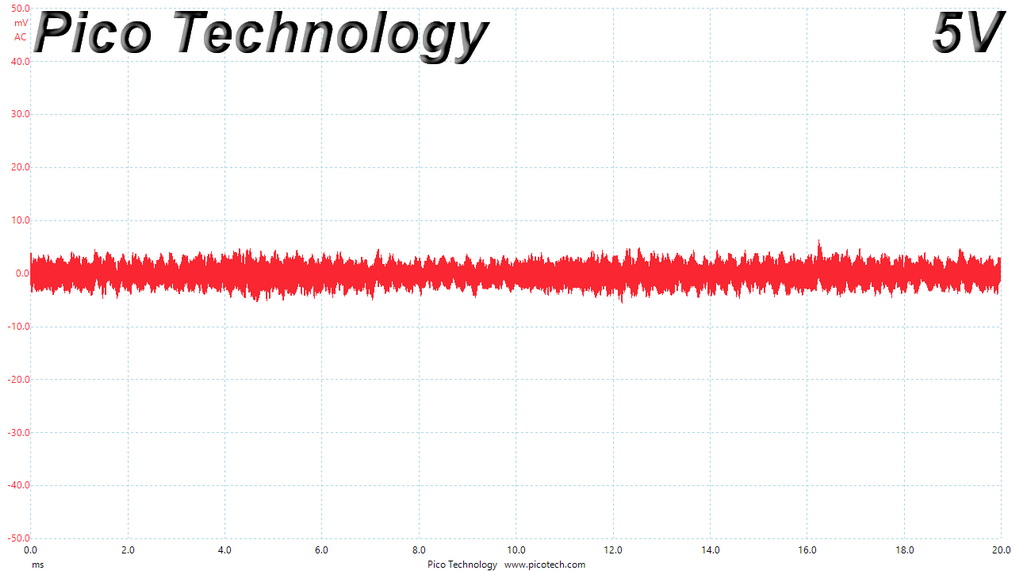


Ripple At Cross-Load 4

Ripple CL4 Load Scope Shots



EMC Pre-Compliance Testing – Average & Quasi-Peak EMI Detector Results
Electromagnetic Compatibility (EMC) is the ability of a device to operate properly in its environment without disrupting the proper operation of other nearby devices.
Electromagnetic Interference (EMI) stands for the electromagnetic energy a device emits, and it can cause problems in other nearby devices if too high. For example, it can be the cause of increased static noise in your headphones and/or speakers.
We found a single spur exceeding the limit with an average EMI detector. Everything is fine, though, with a peak detector.
MORE: Best Power Supplies
MORE: How We Test Power Supplies
MORE: All Power Supply Content
Current page: Transient Response Tests, Timing Tests, Ripple Measurements and EMC Pre-Compliance Testing
Prev Page Protection Features, DC Power Sequencing, Cross-Load Tests and Infrared Images Next Page Performance, Noise, Efficiency and Power Factor
Aris Mpitziopoulos is a contributing editor at Tom's Hardware, covering PSUs.
-
Johnpombrio I own 3 of the EVGA Supernova 850 G2 power supplies with LOTS AND LOTS of extra modular cables 😊. I didn't know that they were legendary, heh. The specs on the side of the PSU are the same as the G6 so I expect that the main difference is the efficiency. I turned on ECO mode and I doubt the fan ever spins.Reply -
taz-nz The biggest improvement is they got rid of the green chrome fan grill from the G5 series.Reply
If it's as reliable as the G2, G3 and G5 series, I look forward to building a lot of PCs with them.
It would be nice if they stepped up their game in cheaper non-modular models, they are significantly lower quality. -
SteelTeel Why is your noise measurement so different from what EVGA posts on its website? Are these measurements carried out with ECO mode enabled?Reply
-
wONKEyeYEs Just picked up a EVGA G1+ 850 W 80+ Gold.Reply
If anything goes wrong I know that I can count on EVGA's
excellent service.
